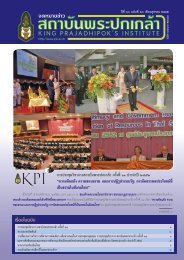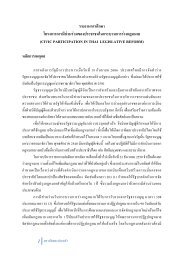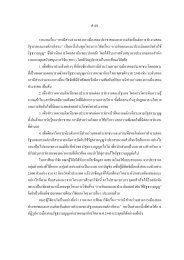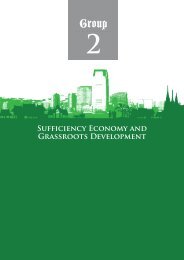Conflict, Legitimacy and Government Reform: Equitable Allocation of ...
Conflict, Legitimacy and Government Reform: Equitable Allocation of ...
Conflict, Legitimacy and Government Reform: Equitable Allocation of ...
You also want an ePaper? Increase the reach of your titles
YUMPU automatically turns print PDFs into web optimized ePapers that Google loves.
100%<br />
80%<br />
60%<br />
40%<br />
20%<br />
0%<br />
Income distribution<br />
Diagram 1<br />
Diagram 1<br />
5th quintile<br />
4th quintile<br />
3rd qunitile<br />
2nd quintile<br />
1st quintile<br />
5<br />
Panel Discussion<br />
1988 1990 1992 1994 1996 1998 2000 2002 2004 2006 2008<br />
Diagram 1 shows GDP ratio (gross domestic products or GDP) <strong>of</strong><br />
the richest 20% compared to the bottom 20% which is the poorest <strong>and</strong><br />
other groups. The ratios <strong>of</strong> these two groups during 1988-2008 reveal<br />
that the ratio <strong>of</strong> the richest 20% is more than 50 per cent <strong>of</strong> total GDP<br />
while the poorest 20% have only about 4 per cent, which is less than the<br />
ratio <strong>of</strong> 6.05 per cent recorded during 1975-1976.<br />
Diagram 1 shows GDP ratio (gross domestic products or GDP) <strong>of</strong> the<br />
richest 20% compared to the bottom 20% which is the poorest <strong>and</strong> other<br />
groups. The ratios <strong>of</strong> these two groups during 1988-2008 reveal that the ratio<br />
<strong>of</strong> the richest 20% is more than 50 per cent <strong>of</strong> total GDP while the poorest<br />
20% have only about 4 per cent, which is less than the ratio <strong>of</strong> 6.05 per cent<br />
recorded during 1975-1976.<br />
When comparing household income by region against average<br />
household income <strong>of</strong> the entire country, inequality can be observed as well<br />
(see Table 3). The Northeast <strong>and</strong> North, including the South in some years,<br />
tend to have the lowest income. When compared to rural areas, distinct<br />
inequality can be observed as well.<br />
When comparing household income by region against average<br />
household income <strong>of</strong> the entire country, inequality can be observed as<br />
well (see Table 3). The Northeast <strong>and</strong> North, including the South in<br />
some years, tend to have the lowest income. When compared to rural<br />
areas, distinct inequality can be observed as well.<br />
43














